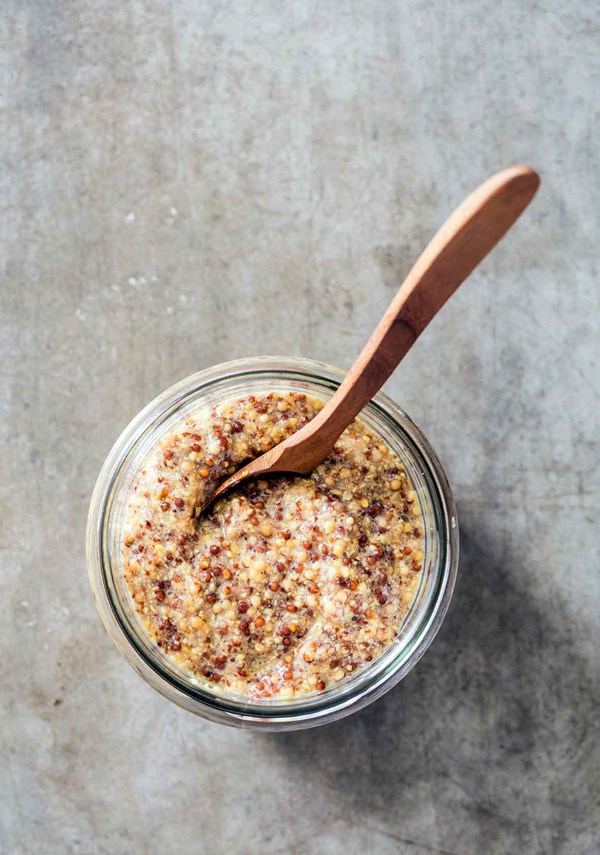Spice support: mustard seed
June 6, 2017 by Darcie
In previous editions of Spice Support, we have focused on ingredients unfamiliar to many Western palates, like mahleb and fenugreek. Today we are looking at a common spice that you may overlook because of its ubiquitous appearance in less than its best form: mustard. Most households have some form of mustard, although frequently you’ll find it in a yellow squirt bottle – arguably not its finest composition.
Mustard is a catchall term for various products made with the mustard plant’s tiny seeds, of which there are three varieties: black (brassica nigra), brown (B. juncea) and white (often referred to as yellow, B. hirta/Sinapis alba). The mustard plants are in the brassica family, which also contains cabbage, broccoli, and cauliflower. Allegedly, an archaic name for mustard is “eye of newt”, giving a new perspective on the witches’ chant in Macbeth. Mustard’s culinary and medicinal uses have been documented for centuries; Pliny discussed its medicinal properties and it even gets a mention in the Bible.
Almost every culture employs some form of mustard in its cuisine. It’s equally at home in Indian, southern Italian, Irish, Mediterranean, Scandinavian, French, and German dishes. It’s an essential ingredient in many pickles, and prepared mustard – that is, mustard seed combined with a liquid such as vinegar – takes a variety of forms from the texturally rich spicy brown to the more refined and mellow Dijon. Mustard works with everything from meat to fish to vegetables. In The Flavor Bible, chef Michael Anthony of Gramercy Tavern in New York says “Tarragon leads me to mustard which leads me to shellfish – which leads me to mussels. The combination of the three is delicious.”
Unlike some ‘exotic’ herbs and spices or complex blends, mustard is inexpensive and is easy to work with at home. Mustard seed can be purchased in bulk and lasts indefinitely. According to The Encyclopedia of Spices and Herbs, mustard seeds have little to no aroma, and their sharp flavor is only activated when it comes into contact with a liquid. Many Indian curries call for cooking the tiny seeds in hot oil until they pop, which releases their pungent flavor into the cooking oil.
Whole mustard seeds keep almost indefinitely, and range in flavor according to their color, with black mustard seeds being the hottest and white/yellow seeds the mildest of the three, with brown seeds falling in the middle flavor-wise. When preparing mustard from powder or seeds, it is best to use cold water as hot water damages the enzymes that provide mustard with its sharp flavor. Cracked or coarsely ground mustard seeds can be used as a rub for meats.
Mustard is in the midst of a renaissance, finding its way into everything from desserts to cocktails. These rapidly growing trends are more than just a gimmick, say mixologists and bakers alike. Chef Paul Denamiel of Le Rivage in NYC uses Dijon mustard in his chocolate mousse. “It’s a hidden kick to the taste buds that unexpectedly comes in though the back door of the palette[sic],” says the chef. Mustard sommelier (who knew that job existed?) Harry Lalousis of Maille mustard explains how mustard can enhance baked goods, noting that it “intensifies flavors by tenfold and creates a tangy flavor that doesn’t make it feel too sweet while enhancing the other ingredient profiles”. Additionally, mustard is an excellent emulsifier (think mayonnaise), an attribute works well in desserts too. In cocktails, mustard “adds spice, creaminess and a velvety mouthfeel,” says mixologist Torrence Swain.
Homemade flavored or specialty mustards make great gifts are and exceedingly easy to make. The EYB Library contains several “how to” recipes, including the How to make homemade whole grain mustard from Leite’s Culinary and America’s Test Kitchen (pictured top), How to make Dijon-style mustard from Food Wishes by John Mitzewich, Homemade mustard by David Lebovitz, Homemade fig mustard from Food in Jars by Marisa McClellan, and Master recipe for pickled seeds from Bon Appetit Magazine.
Categories
- All Posts (6940)
- Antipasto (2135)
- Author Articles (247)
- Book News (935)
- Cookbook Giveaways (983)
- Cookbook Lovers (257)
- Cooking Tips (109)
- Culinary News (299)
- Food Biz People (552)
- Food Online (791)
- Holidays & Celebrations (272)
- New Cookbooks (149)
- Recipes (1500)
- Shelf Life With Susie (231)
- What's New on EYB (133)
Archives
Latest Comments
- hibeez on How cookbooks can help build resilience
- Pamsy on What foods do you look forward to the most for each season?
- Pamsy on How cookbooks can help build resilience
- DarcyVaughn on Danube Cookbook Review and Giveaway
- hettar7 on JoyFull – Cookbook Review & Giveaway
- eliza on What foods do you look forward to the most for each season?
- kmwyman on Rooza by Nadiya Hussain – Cookbook Review and Giveaway
- Maryd8822 on The Golden Wok – Cookbook Giveaway
- Dendav on Danube Cookbook Review and Giveaway
- sanfrannative on Rooza by Nadiya Hussain – Cookbook Review and Giveaway